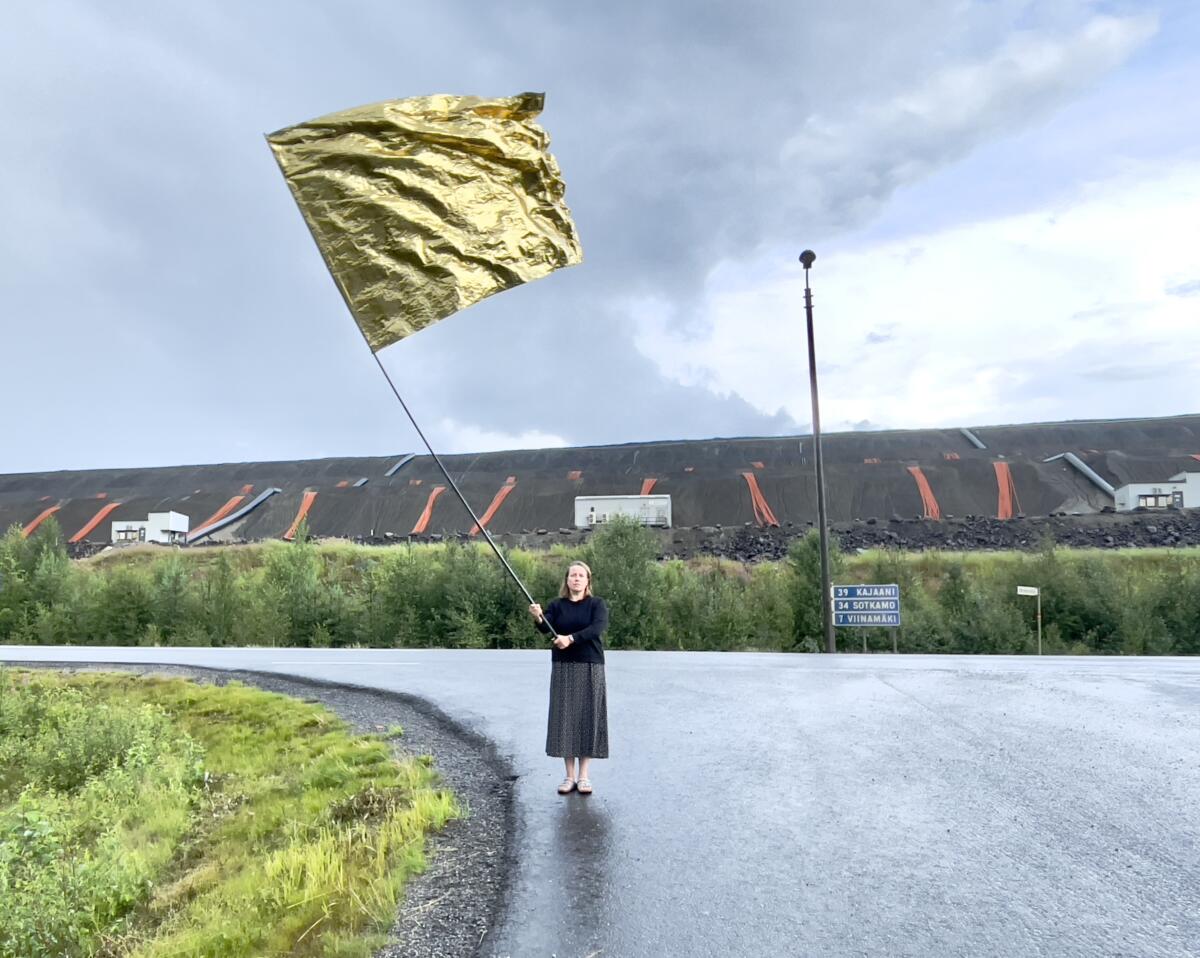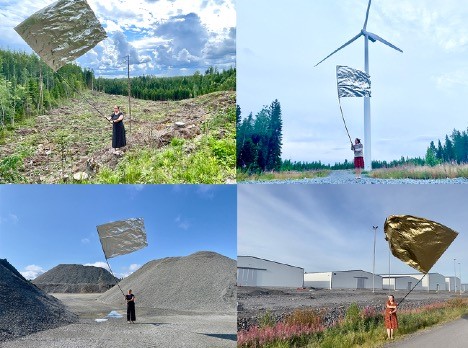Greetings from Places I Never Wanted to Visit
Leena Kela writes about her travels around Finland visiting sites of environmental damage by extraction.
Leena Kela

We are approaching the Monster. I can sense its heavy breath, from the way it spews dust like ash around its big round body. I prepare myself for the encounter about to unfold…
In the previous week I had researched and rehearsed this trip on a map. I used Google Earth to understand how vast the area is and how to find a spot where it might be possible to get a glimpse of it. I was looking for a place where the blocked roads and high fences wouldn’t prevent us from getting close to the Monster. There is only one road left that has not yet been occupied by them. It is a public road leading to a tiny village that has been trapped by the Monster’s ever-expanding body and limbs. But due to the active resistance of the locals, they haven’t managed to capture this road yet. And here we are – me, my partner, our daughter and our dog – on our summer holiday trip through Finland.
I feel nervous. What if they spot us? There are cameras everywhere and big signs that say: “Private property, no entry without permission”. I try to calm myself. This is still a public road. We approach a point where the road turns away from the Monster, and I realise, this is the closest I can get to it. I check which way the security cameras point and park the car on the side of the road where I assume we should be out of sight for the ongoing surveillance. It is time to get out of the car and do my part. My partner is ready with the camera. I take my flag from the boot and walk closer to the Monster. I feel its cold presence and my back shivers. I can smell its sulphurous breath.
I start to wave the flag. The familiar movement and soothing sound help me to calm my nerves. I know what I am doing. I am flagging to commemorate the loss of biodiversity in this area. I am flagging to commemorate Finland’s worst environmental disaster.
Following the first leak in 2010, two other major leaks released pollutants into the surrounding area. The first of these took place in November 2012, and also involved a leakage from a gypsum waste pond, discharging nickel, uranium and other toxic metals and effluents into nearby surroundings and lakes. As the Kainuu Employment and Economic Development Centre pointed out, the company had used the gypsum for storing waste waters without a permit to do so, prompting the Minister of Environment, Ville Niinistö, to label the leak a “serious environmental crime”. Earlier the same year, a mine employee died from hydrogen sulphide poisoning in the area of the mine, and dozens of dead waterbirds were discovered in an open pond. Dust and noxious odours had dispersed over a wide area, travelling as far as 100 kilometres away. [1]
What is it like to be a tourist and visit places that are not meant for the eyes of outsiders? These are places that would never be mentioned when a town or village advertises for visitors. These are places of destruction, shame and sometimes even crime. As in the case of the Monster.

In the summer of 2023, I travelled around Finland visiting places that have been permanently or remarkably destroyed by human activity. I made a flagging ceremony with an emergency blanket to commemorate the losses in the areas. The performance was documented with a photograph, which I then sent as a postcard to Tallin, to the Hobusepea Gallery, where I took part in a group exhibition called Like a Windless Cloud. [2] The places I visited were a granite quarry in Taivassalo, a logging area in Mynämäki, a peat extraction site in Laitila, a freight terminal for China’s New Silk Road in Kouvola, a clear-cut in Kitee, the Talvivaara nickel mine in Sotkamo, a gravel pit in Kuusamo, a nuclear power plant and village in Pyhäjoki, where construction was halted in 2022 due to Russia’s war on Ukraine, and the Mutkalampi wind farm in Kannus, which is Finland’s largest wind farm with a total of 69 wind turbines. My aim is to continue working with the project and to visit more sites of destruction.
It is another day and we are driving again. I haven’t thought about a flag ceremony today. We have been visiting our relatives in their summer cottage close to the Russian border, and now we are driving along the endless winding roads in the shadow of the economic forests. The road bends and a new site of destruction unfolds before my eyes. A fresh clear cut. It looks as if the forestry machine has only left the site a week ago. The trunks are still fresh and dripping with resin. The sight is nothing short of misery. I have a lump in my throat. It is hard to swallow. We stop and I take the flag from the trunk and start flagging. I flag for the birds that used to nest here, for the pines, birches, spruces, mosses, beetles, ants, butterflies, mushrooms and so on. I am also flagging to deal with the anxiety that this place causes in me. A place I never wanted to visit as it is today.

The Anthropocene, which literally means” the age of the human being” designates a new era in the history of the earth that follows the ten million years of the Holocene. There is nothing narcissistic about the reference to our species: it only points out the disastrous hegemony of humans over the other species, the breadth and volume of our activities having a “geological force” capable of modifying the planet – no more of less than a virus. The term “Capitalocene”, coined by the Swedish author Andreas Malm, underlines the fact that the threat does come from human activities, inasmuch as they are shaped by a profit-driven globalized production system and the privatization and intensive exploitation of natural resources. [3]
Extraction in the form of mining, forestry and agriculture requires practices to transport, store and sort raw materials. These are all part of extraction and require both material and financial resources. Once a new mine is built and the material it produces is extracted from the earth, it requires extensive road infrastructure and transport systems to deliver it and turn it into a commodity. Extraction generates capital, and capital constantly invests heavily in discovering and exploring new sources for further extraction. [4] In 2022 a new freight terminal – which was meant to be part of China’s New Silk Road – was built in Kouvola to handle and transport goods between Europe, China and Russia. The terminal costed 34 million euros and is not in use because of Russia’s war on Ukraine. No one knows if the connection will ever be opened. I visited there to flag for the 42 hectares of forest that were cut down in order to build the terminal which remains empty. I flagged together with the wind that swept across the vast expanse of asphalt.
Notes
1. EJOLT, Environmental Justice Organisations, Liabilities and Trade. 2015. Talvivaara Mine Environmental Disaster. http://www.ejolt.org/wordpress/wp-content/uploads/2015/07/FS-37.pdfhttp://www.ejolt.org/wordpress/wp-content/uploads/2015/07/FS-37.pdf
2. Echo Gone Wrong. 2023. Photo reportage from the exhibition ‘Like a Windless Cloud’ at Hobusepea Gallery. https://echogonewrong.com/photo-reportage-from-the-exhibition-exhibition-like-a-windless-cloud-at-hobusepea-gallery/
3. Bourriaud, Nicolas. 2022. Inclusions: Aesthetics of the Capitalocene. London: Sternberg Press (page 18).
4. Mezzadra, Sandro, and Brett Neilson. 2017. On the multiple frontiers of extraction: excavating contemporary capitalism. Cultural Studies 31, no. 2-3. (page 6)
Bibliography
1. Bourriaud, Nicolas. 2022. Inclusions: Aesthetics of the Capitalocene. London: Sternberg Press.
2. Echo Gone Wrong. 2023. Photo reportage from the exhibition ‘Like a Windless Cloud’ at Hobusepea Gallery. https://echogonewrong.com/photo-reportage-from-the-exhibition-exhibition-like-a-windless-cloud-at-hobusepea-gallery/
3. EJOLT, Environmental Justice Organisations, Liabilities and Trade. 2015. Talvivaara Mine Environmental Disaster. http://www.ejolt.org/wordpress/wp-content/uploads/2015/07/FS-37.pdf
4. Mezzadra, Sandro, and Brett Neilson. 2017. On the multiple frontiers of extraction: excavating contemporary capitalism. Cultural Studies 31, no. 2-3: 185-204.
Artist Bio: Leena Kela is a performance artist, a doctoral candidate at the Academy of Fine Arts of the University of the Arts Helsinki, artistic director of the New Performance Turku Biennale and a director of the Saari Residence. In her works and research, she explores dialogue between corporeality and materiality in performance art. She makes performances that play with and twist our relationship with everyday objects, perceptions and phenomena. She has presented her performances internationally at performance art festivals, events and exhibitions on every continent except Antarctica. www.leenakela.com
Ecological Thinking
This is the course blog for K-JI-11-23A – Ecological Thinking. In 2023-24, we explore “Vertical Ecologies” by visual arts, film and performance. The course is co-organized by Giovanna Esposito Yussif and Samir Bhowmik. Previously, in 2022-23, we organized a year-long collaborative research studio with Aarhus University, DK, Research Pavilion 2023 and Helsinki Biennial 2023 on the themes of environmental data, sensing and contamination.
Header image credit: Abelardo Gil-Fournier and Jussi Parikka / Seed, Image, Ground (2020)- With permission from the authors.
Latest posts
-
Ecocidal Development and Atmospheric Warfare - Guest Lecture by David Muñoz Alcántara, 18.3.
-
"Schizophrenic relationship with nature" - Guest Lecture by Matti Aikio, 12.2.
Follow blog